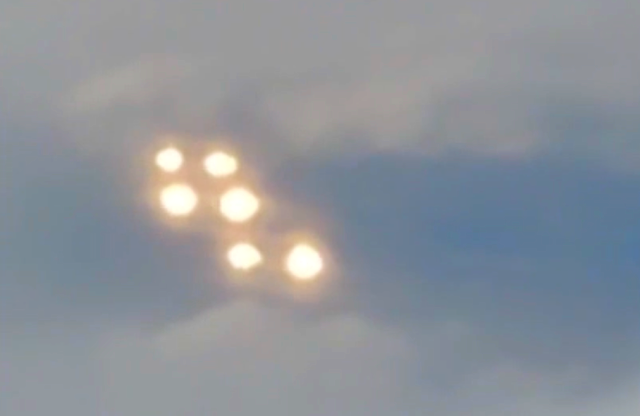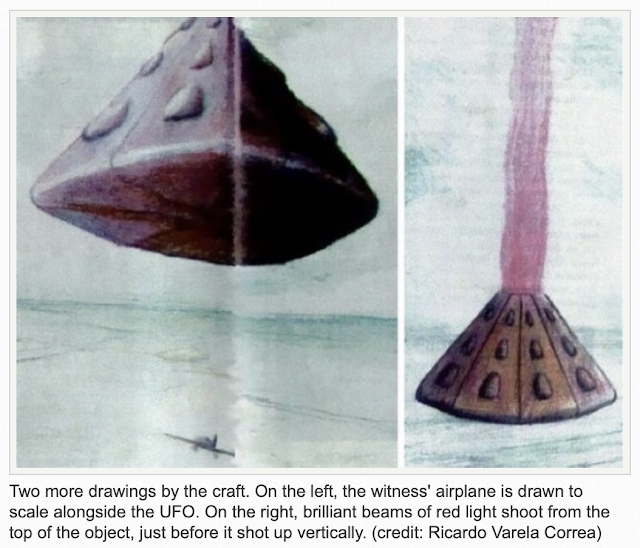Location of sighting: New Mexico
Source: MUFON


On October 5, 1996, Haraldo Westendorf, a 40-year-old successful businessman and avid private pilot, had a remarkable and unforgettable encounter with an enormous unidentified flying object (UFO) over Pelotas, Brazil. During a routine recreational flight, Westendorf found himself within meters of a giant pyramid-shaped craft, an experience that has since been recounted as one of the most impressive UFO sightings in recent history. This article delves into Westendorf’s encounter, his observations, and the broader implications of this event.
Background: Haraldo Westendorf, a seasoned pilot with 20 years of experience, took off from Pelotas, near the southern tip of Brazil, on the morning of October 5, 1996. Flying his single-engine Embraer EMB-712, a Brazilian version of the Piper Cherokee Archer II, Westendorf intended to enjoy a routine flight over the region.
Initial Sighting: Approximately 12 minutes into his flight, at an altitude of 5,000 feet over a large lake five miles southeast of Pelotas, Westendorf noticed an enormous aerial object ahead. The time was around 10:30 a.m. He contacted the Pelotas air tower to confirm the object’s visibility from the ground, which they did, asking him for a closer inspection.
Close Encounter: Intrigued and skeptical about UFOs, Westendorf decided to approach the object. As he drew closer, he realized that this was unlike anything he had seen in his extensive piloting career, which included stunt training in the United States and flights in France. The object was a faceted cone, flat on the bottom with a rounded point on top, approximately 70 meters (225 feet) high and 100 meters (325 feet) in diameter. It had several large bulges on its sloping side panels, resembling triangle-shaped bay windows.
Detailed Observations: Westendorf spent about 12 to 14 minutes circling the object, managing to fly around its base three times. He observed the object spinning slowly and moving southeast toward the coast at about 60 nautical miles per hour. At one point, his plane came within 40 meters of the UFO. He noted that the object’s top appeared to open, from which a smaller, classic flying saucer emerged and shot away at tremendous speed, estimated at over Mach 10.
The Departure: Attempting to gain a better view of the object’s interior, Westendorf flew his plane several hundred meters away and began a steep climb. Suddenly, the object started rotating faster, emitting brilliant red beams of light. The object then ascended rapidly, and Westendorf, fearing a shock wave that could endanger his plane, prepared for emergency procedures. Surprisingly, he encountered no turbulence as the object vanished into the sky.
Eyewitness Credibility: Haraldo Westendorf’s background as an experienced pilot adds significant credibility to his account. His detailed observations, coupled with his knowledge of advanced and exotic aircraft, make his encounter particularly compelling.
Unique Characteristics: The object’s faceted cone shape with bulges and the emergence of a smaller saucer-shaped craft are unique characteristics that distinguish this sighting from other UFO reports. The detailed illustrations and descriptions provided by Westendorf enhance the authenticity of his experience.
Lack of Radar Confirmation: Although Westendorf believes the object was tracked by the radar at Curitiba airport, officials denied any such tracking. This lack of radar confirmation adds an element of mystery to the encounter, highlighting the limitations of existing tracking technology in capturing such phenomena.
Technological Insights: The UFO’s ability to hover, spin, and accelerate rapidly without producing turbulence suggests advanced propulsion technology far beyond current human capabilities. Understanding such technology could revolutionize aerospace engineering and transportation.
Extraterrestrial Hypothesis: The size, shape, and behavior of the object, along with the emergence of a smaller saucer, strongly suggest the involvement of an advanced extraterrestrial civilization. This sighting provides significant evidence supporting the hypothesis that we are not alone in the universe.
Scientific Inquiry: Westendorf’s encounter highlights the need for rigorous scientific inquiry into UFO phenomena. Systematic investigations could lead to groundbreaking discoveries about the nature of these objects and their origins.
Public Awareness and Policy: High-profile sightings like this one raise public awareness and interest in UFO phenomena. They also emphasize the need for transparent and systematic policies for reporting and investigating such encounters by aviation authorities and governments.
Brazil has a rich history of UFO sightings, with several high-profile cases drawing significant attention from both the public and researchers. Here are a few notable examples:
The Varginha Incident (1996): In January 1996, three young women in Varginha, Brazil, reported seeing a strange creature with a large head and red eyes. This incident, often referred to as "Brazil's Roswell," included multiple sightings and alleged military involvement in recovering alien bodies and a crashed UFO.
The Colares Flap (1977): A wave of UFO sightings and close encounters occurred in Colares, Pará, in 1977. Local residents reported being attacked by beams of light from flying objects, which caused burns and other injuries. The Brazilian Air Force conducted an investigation, known as Operation Saucer, which remains controversial.
The Trindade Island Sighting (1958): A series of UFO sightings near Trindade Island were documented by the Brazilian Navy. The most famous incident involved photographs taken by photographer Almiro Baraúna, showing a saucer-shaped object near the island. These photos were officially released by the Brazilian Navy.
The São Paulo UFOs (1986): In May 1986, several UFOs were detected by radar and sighted visually over São Paulo. The Brazilian Air Force scrambled fighter jets to intercept the objects, but the UFOs performed maneuvers that outpaced the jets. This incident is known as "The Night of the UFOs" in Brazil.
The Antonio Villas Boas Abduction (1957): One of the earliest abduction cases, Antonio Villas Boas, a Brazilian farmer, reported being abducted by humanoid aliens in October 1957. He described being taken aboard a UFO, where he underwent medical examinations and had an encounter.
Haraldo Westendorf's encounter with a giant pyramid-shaped UFO over Pelotas, Brazil, on October 5, 1996, stands as one of the most compelling UFO sightings in history. His detailed observations, combined with his credibility as an experienced pilot, provide a strong case for the existence of advanced, possibly extraterrestrial technology. The encounter's unique characteristics, including the faceted cone shape of the UFO and the emergence of a smaller saucer-shaped craft, add to the intrigue and significance of this sighting.
The implications of such an encounter are profound. From technological insights that could revolutionize aerospace engineering to the possibility of contact with extraterrestrial civilizations, this event challenges our understanding of the universe and our place within it. It underscores the need for rigorous scientific inquiry and transparent policies for reporting and investigating UFO sightings.
Brazil's rich history of UFO encounters, including notable incidents like the Varginha Incident, the Colares Flap, and the Trindade Island Sighting, provides a broader context for Westendorf's experience. These cases highlight the global nature of UFO phenomena and the importance of international collaboration in studying these mysterious objects.
As we continue to explore and investigate these phenomena, high-profile sightings like Westendorf's remind us of the vast and mysterious nature of the universe. They inspire curiosity and encourage us to look beyond the familiar, embrace the unknown, and pursue knowledge with determination. By doing so, we move closer to understanding the truth about UFOs and the potential existence of extraterrestrial life.







